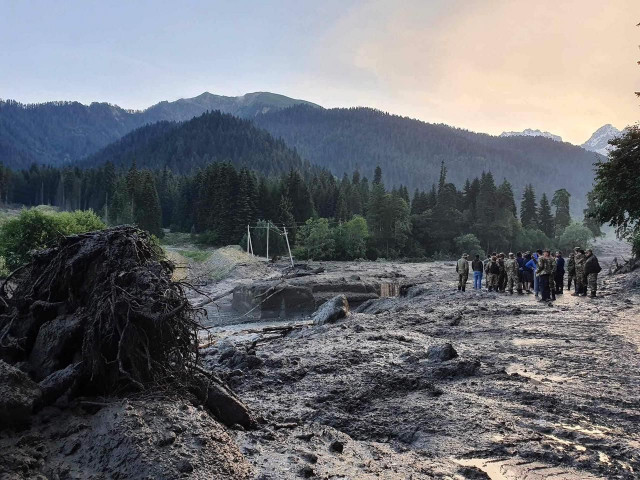On the Move: Migration Challenges in Mountainous Switzerland and Georgia
Written by Nils Besson, Hannah Fairless, Luka Iremashvili & Liza Tsiklauri, a collaboration between students of the Tbilisi State University and the University of Zurich
Switzerland and Georgia are two countries, which are characterized by their landscapes. Both countries are host to an enormous mountain ranges, which lend the countries their breathtaking views and charisma. However, even these pristine areas with indomitable populations are not left untouched by climate change. While the most prominent threat is the increased warmth, it does not come alone. The weather is expected to become more extreme in the coming years, with more storm-like precipitation (Beniston, 2003; Stoffel, Wyżga & Marston, 2016).
The effect of the accelerating climate change in Switzerland, which is renowned for its snow-capped Alps and crystal-clear lakes, is clearly visible in the summer months. Increasing temperatures have caused the melting of glaciers at a faster rate, hence promoting the formation of glacial lakes and discharge into the lower lying regions of Switzerland (Beniston, 2003). This enlarged amount of water being carried by the rivers is not a problem per se. However, if this 'natural' discharge is combined with a large rain-event, the normally narrow and slow streams can transform into torrents, destroying whole villages (Stoffel, Wyżga & Marston, 2016). These events are unfortunately not only limited to the Alps but are occurring in practically every mountainous region on the globe (Stoffel, Wyżga & Marston, 2016). Like in Switzerland, the Georgian population are endangered by these flash floods. Naturally, the effected governments have made it a priority to find possible solutions for the mountain villages (Kupiszewski et al., 2000; Davlianidze, 2021).
Both Switzerland and Georgia have realized the necessity of an adaptive strategy. In Switzerland, the emphasis is being placed on enhancing infrastructure, providing early warning systems and developing more sustainable methods of land management (Stoffel, Wyżga & Marston, 2016). Early warning systems are of course just one way to minimize casualties and reduce damage to the infrastructure in villages. Therefore, some inhabitants are choosing to take matters into their own hands and moving into safer, lower situated regions of the country (Camenisch & Debarbieux, 2011). In Georgia, the solutions implemented by the government are sparser than in Switzerland. With less protection, the danger of a fatal flood event is increasing steadily with the escalating effects of the climate change (Beniston, 2003; Stoffel, Wyżga & Marston, 2016). Yet Georgia's mountainous communities, are strongly based on their traditional values. Therefore, they would have to choose between the relocation to a safer place of residence and abandoning their traditions or staying and potentially risk their lives but remain loyal to the traditions (Davlianidze, 2021).
The overall conclusion is that the climatic conditions affecting mountain environments in Switzerland and Georgia are harsh realities for climate change. The initial problem for Switzerland is melting ice leading to floods in the mountainous regions of this country. However, Georgia struggles with an issue of balancing traditional heritage and flood risk, having been much less active in prevention. The necessity of flexible solutions is emphasized in both countries, as it constitutes the worldwide phenomenon required by the fragile environment and communities.
Literature:
Beniston, M. (2003) 'Climatic Change in Mountain Regions: A Review of Possible Impacts', in: Diaz, H.F. (eds.) Climate Variability and Change in High Elevation Regions: Past, Present & Future. Advances in Global Change Research, vol 15, Springer, Dordrecht, pp. 5–31. doi: 10.1007/978-94-015-1252-7_2.
Camenisch, M. & Debarbieux, B. (2011) 'Inter-communal migrations in Switzerland: a "mountain factor"?', Journal of Alpine Research, 99(1), pp. 1–13. doi: 10.4000/rga.1368.
Kupiszewski, M., Schuler, M., Reichle, M., Durham, H. & Rees, P. (2000) 'Internal migration and regional population dynamics in Europe: Switzerland case study', Working Paper of the University of Leeds, School of Geography, pp. 1–89.
Davlianidze, N. (2021) 'Transnational Amenity Migrants in the Mountainous Regions of the Republic of Georgia: Motives to Move, Adaptation Strategies, Integration into the Local Community', Thesis, College of Arts and Sciences of Ohio University.
Stoffel, M., Wyżga, B. & Marston, R. A. (2016) 'Floods in mountain environments: A synthesis', Geomorphology, 272, pp. 1–9. doi: 10.1016/j.geomorph.2016.07.008.
Figure:
Levshits, N. (2023) 'The death toll after a landslide in Racha has increased: so far the bodies of 6 people have been found, Nikolay Levshits about Georgia in Russian', Available at: https://nlevshits.com/chislo-pogibshih-posle-opolznya-v-rache-uv/ (accessed 04.12.2023).
Related Posts
Comments
By accepting you will be accessing a service provided by a third-party external to https://www.mountainapp.net/
This website uses no external trackers, no analytics, just session cookies and values your online privacy.



